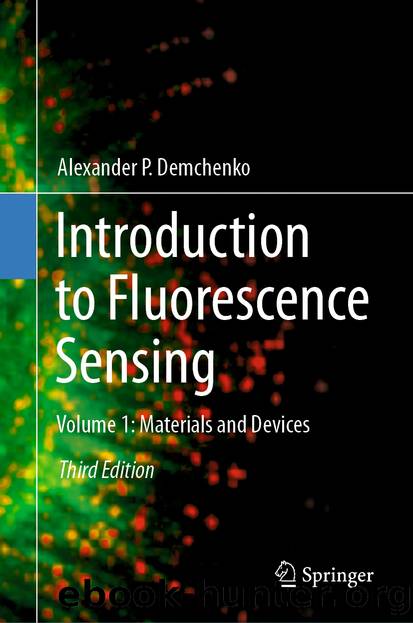Introduction to Fluorescence Sensing by Alexander P. Demchenko

Author:Alexander P. Demchenko
Language: eng
Format: epub
ISBN: 9783030601553
Publisher: Springer International Publishing
8.3.1 Dye Aggregates: Emissive and Quenched
It is a textbook knowledge that the organic dye aggregation generally quenches the light emission (Birks 1970). The electronic interactions between closely located fluorescent dyes result in a process known as aggregation-caused quenching (Hong et al. 2011). It causes great problems dissipating nonproductively the excitation energy. As discussed above, the mechanisms of such quenching and the possibilities of its prevention in dye-doped nanostructures are important to be discussed and accounted in nanoparticle design. Some authors (Battistelli et al. 2016) suggest to distinguish the aggregation-caused quenching (ACQ) and proximity-caused quenching (PCQ). Thus, the photoinduced electron transfer (PET) quenching discussed in Sect. 4.â1 should belong to ACQ and the quenching through distance by energy transfer (see Fig. 8.3) to PCQ. For avoiding the PET quenching, one has to construct the nanoparticles, in which the close presence of strong electron donor or electron acceptor groups is eliminated. The other typical mechanisms of quenching are that involving the formation of non-emissive H-aggregates in the ground state and the exciplexes, which are the intermolecular complexes in the excited states requiring definite stoichiometry (Davidson 1983). Such stoichiometry should be avoided on the dye aggregation.
The fluorescence quenching can be observed even in the absence of direct intermolecular interactions at the ground or excited state, just because of simple proximity of the dyes in ensemble. We could see (Fig. 8.3) that efficient homo-EET between the dyes that can be located at a distance of several nanometers in the presence of non-emissive EET acceptor leads to complete quenching. Thus, the nanostructures not only with close packing of the dyes but also with their location within nanometer distances may not be good emitters. The aim of researcher is to avoid such energy traps.
Are there exceptions to the rule that emission of dyes in their solid aggregated states should be always quenched? Hopefully there are a number of organic dyes emitting in the solid state (Anthony 2012; Shimizu and Hiyama 2010), and their great popularity is attributable to their applications in organic photovoltaics and other energy conversion devices. Those are the borate complexes of ionic dyes (Frath et al. 2014) and some dyes displaying excited-state intramolecular proton transfer (ESIPT) (Carayon and Fery-Forgues 2017; Padalkar and Seki 2016). They demonstrate attractive optical properties, such as high absorption coefficients, red-shifted emission wavelengths and high quantum yields. Obtaining and stabilizing the formed nanoparticles in solutions may involve technical problems. Their successful outcome was reported based on analysis of various chemical structures, even resulting in formation of the nanoparticles of different shapes (Carayon and Fery-Forgues 2017). Of particular interest are the nanoparticles formed of BODIPY dyes assembled spontaneously in aqueous solutions (Zhang et al. 2019).
Download
This site does not store any files on its server. We only index and link to content provided by other sites. Please contact the content providers to delete copyright contents if any and email us, we'll remove relevant links or contents immediately.
The Complete Stick Figure Physics Tutorials by Allen Sarah(7264)
Secrets of Antigravity Propulsion: Tesla, UFOs, and Classified Aerospace Technology by Ph.D. Paul A. Laviolette(5237)
Thing Explainer by Randall Munroe(3849)
The River of Consciousness by Oliver Sacks(3498)
The Order of Time by Carlo Rovelli(3096)
How To by Randall Munroe(2969)
A Brief History of Time by Stephen Hawking(2911)
I Live in the Future & Here's How It Works by Nick Bilton(2900)
The Great Unknown by Marcus du Sautoy(2612)
What If?: Serious Scientific Answers to Absurd Hypothetical Questions by Randall Munroe(2587)
Midnight in Chernobyl by Adam Higginbotham(2432)
Blockchain: Ultimate Step By Step Guide To Understanding Blockchain Technology, Bitcoin Creation, and the future of Money (Novice to Expert) by Keizer Söze(2409)
Networks: An Introduction by Newman Mark(2303)
The Meaning of it All by Richard Feynman(2268)
Easy Electronics by Charles Platt(2252)
The Tao of Physics by Fritjof Capra(2204)
Midnight in Chernobyl: The Untold Story of the World's Greatest Nuclear Disaster by Adam Higginbotham(2126)
When by Daniel H Pink(2057)
Introducing Relativity by Bruce Bassett(2048)
